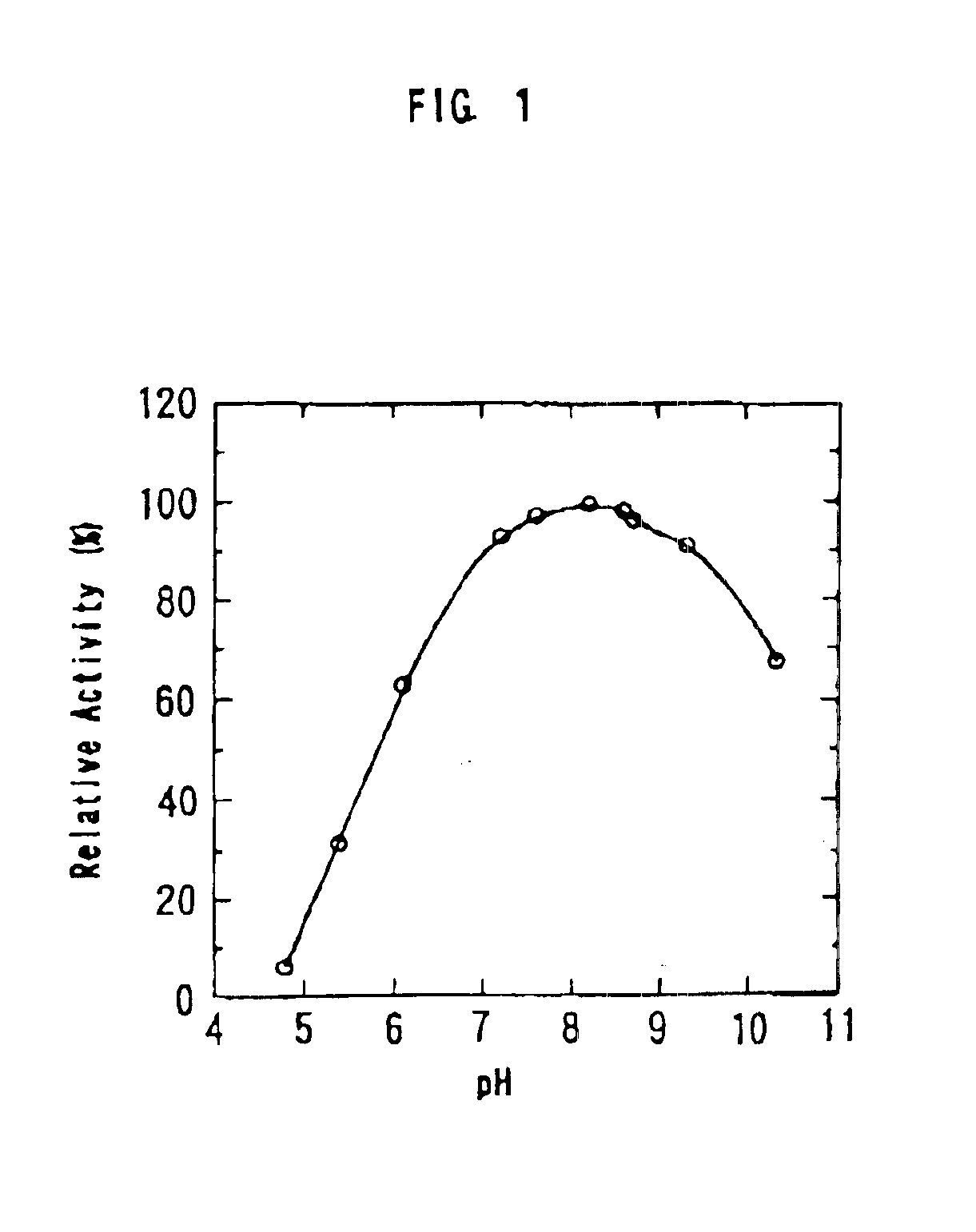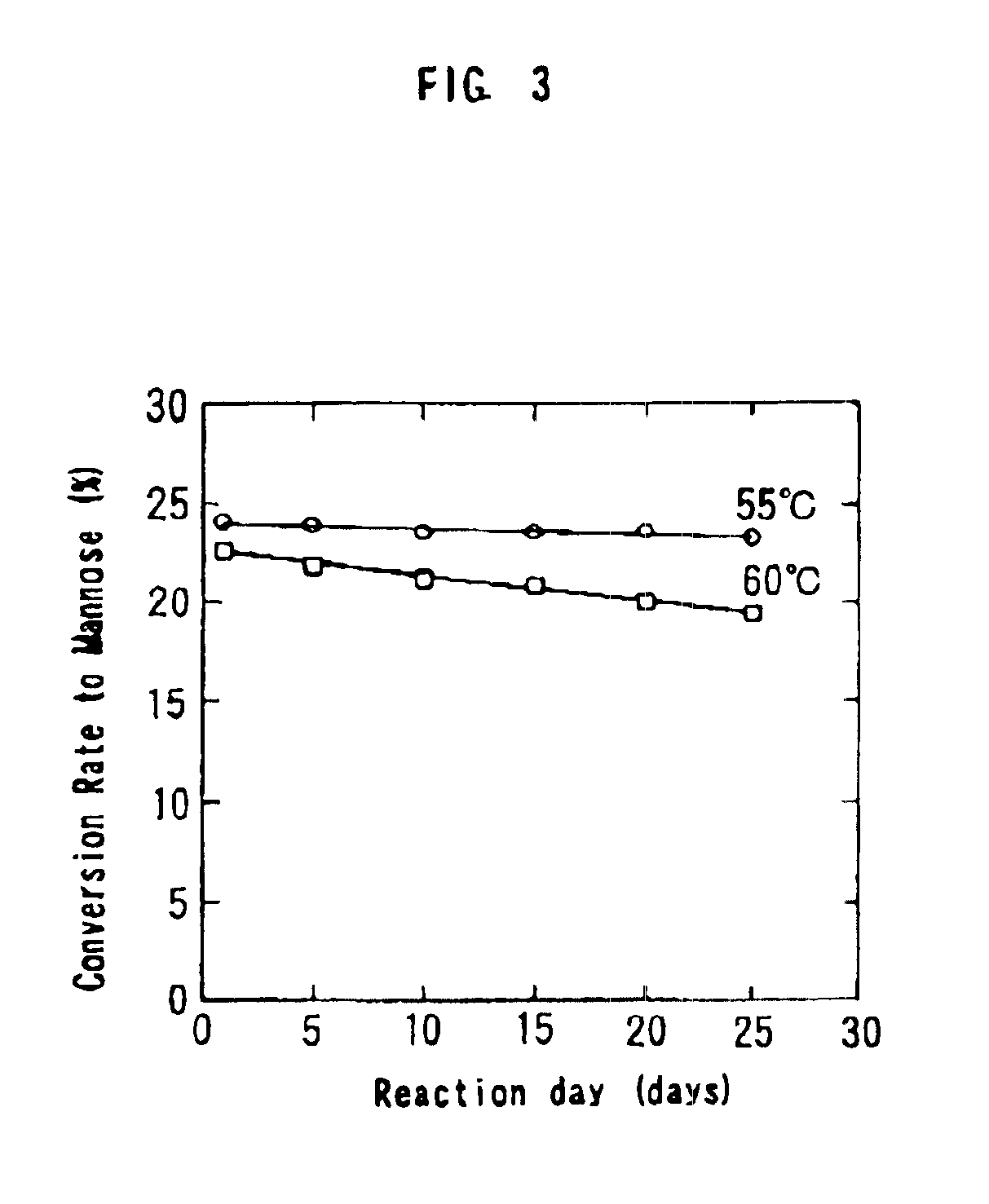Heat-resistant mannose isomerase, process for producing the same and process for producing mannose by using the same
a technology of thermostable mannose and isomerase, which is applied in the direction of oxidoreductases, biochemistry apparatus and processes, enzymes, etc., can solve the problems of poor thermostability, high cost of mannose, and problems for industrial us
- Summary
- Abstract
- Description
- Claims
- Application Information
AI Technical Summary
Problems solved by technology
Method used
Image
Examples
example 1
[0065]250 ml of medium (pH 6) containing 2% of polypeptone, 1% of glucose, 0.2% of yeast extract, 0.3% of K2HPO4, and 0.03% of MgSO4.7H2O, was put into an Erlenmeyer flask of 1 liter capacity, sterilized in an autoclave at 121° C. for 15 minutes, inoculated with Agrobacterium tumefaciens IFO 12664 (ATCC 4718) and subjected to shaking culture at 30° C. for 3 days.
[0066]After the cultivation, resultant cells were recovered by centrifugation, rinsed, and parts were disintegrated by an ultrasonic cell disintegrator of 20 KC, followed by the measurement of the activity of the extracted mannose isomerase.
[0067]As a result, 0.9 unit of a thermostable mannose isomerase per 1 ml of the cultivation solution was obtained.
example 2
[0068]To test tubes of 18 mm in diameter, 4 ml of media (pH 6.8) each containing 1% of mannose, fructose, glucose, galactose, lactose, maltose or dextrin as the carbon source, 1% of polypeptone, 0.2% of K2HPO4 and 0.05% of MgSO4.7H2O 4 ml, were added, sterilized by conventional methods, and inoculated with Agrobacterium tumefaciens IFO 12664, followed by shaking culture at 30° C. for 3 days. After cultivation, the activity of the resultant mannose isomerase was measured as described in Example 1.
[0069]Results of the activity measurements are shown in Table 2. Table 2 shows that all of the added carbon sources proved to be effective compared to the medium without any carbon source; the thermostable mannose isomerase of the present invention was therefore confirmed to be an enzyme which may be produced constitutively.
[0070]
TABLE 2Carbon sourceAmount of ceMannose Isomerase(1%)Final pH(660 nm)(unit / ml medium)none8.00.900.15mannose8.42.550.72fructose7.22.400.75gluocose8.52.700.80galactos...
experiment 1
[0071]Using the thermostable mannose isomerase prepared in Example 1, the effect of pH on mannose isomerase reaction was examined.
[0072]50 mm each of acetic acid buffer (pH 4.5 to 6.0), tris-HCl buffer (pH 7 to 8.6), glycine-NaOH buffer (pH 8.0 to 10.5) and phosphate buffer (Na2HPO4—NaOH, pH 8 to 11), 0.1M of mannose and 0.15 units of mannose isomerase were added to form a mixture with a total volume of 0.4 ml, and reacted at 40° C. for 30 minutes. The amount of fructose produced was determined by the cysteine-carbazole process. The relative activities at each pHs are shown in Table 3 and FIG. 1, with the activity at pH 8.2, which was the maximum activity, defined as 100.
[0073]
TABLE 3Reaction pHRelative Activity (%)1.85.65.431.36.163.07.293.47.697.18.2100.08.698.38.796.49.391.110.367.711.19.2
PUM
| Property | Measurement | Unit |
|---|---|---|
| temperature | aaaaa | aaaaa |
| temperatures | aaaaa | aaaaa |
| temperature | aaaaa | aaaaa |
Abstract
Description
Claims
Application Information
 Login to View More
Login to View More - R&D
- Intellectual Property
- Life Sciences
- Materials
- Tech Scout
- Unparalleled Data Quality
- Higher Quality Content
- 60% Fewer Hallucinations
Browse by: Latest US Patents, China's latest patents, Technical Efficacy Thesaurus, Application Domain, Technology Topic, Popular Technical Reports.
© 2025 PatSnap. All rights reserved.Legal|Privacy policy|Modern Slavery Act Transparency Statement|Sitemap|About US| Contact US: help@patsnap.com



